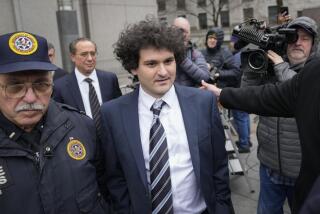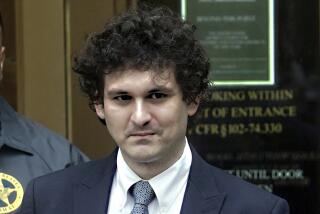Clausen, Armacost Blamed for Bank’s Decline : Book on B of A Stirs Controversy
- Share via
SAN FRANCISCO — A week before its official release, “Breaking the Bank: The Decline of BankAmerica” is already stirring up a storm.
And the management of the bank holding company, once the nation’s biggest, is readying its defenses against the criticisms by author Gary Hector.
Hector, also an associate editor of Fortune magazine, puts the blame for the bank’s financial troubles squarely on the shoulders of management, board directors and advisers, past and present, who he says failed to prepare for the stiff competition the bank would face in the 1980s.
He blames both A. W. Clausen, who led the company in the 1970s and returned in 1986, and Samuel Armacost, who headed up the bank in the years between Clausen’s leadership.
Hector predicts that the bank holding company will enjoy only a mild recovery from its darkest days.
“BankAmerica grew too large for the management systems it had, but that does not excuse the men who managed the company,” Hector writes.
It leaders “made mistakes right out of management textbooks: decentralizing without proper controls, losing touch with customers and markets, spending lavishly on technology (more than $2 billion over five years, only to end up with a system still considered antiquated by the industry), and failing to find appropriate ways to measure and reward the performance of executives.”
Firm ‘Disappointed’
BankAmerica counters that the book is outdated.
The San Francisco-based bank holding company lost nearly $2 billion from 1985 to 1987 but last month reported its fourth consecutive quarter of profitability.
In a statement responding to the book, BankAmerica said: “We are disappointed that this book has such a slanted perspective and is so lacking in balance. Events have passed it by. BankAmerica has turned around and is solidly on the road to recovery.”
In an interview, Hector said it is obvious the bank is doing well working out its troubled loans, both international and domestic, though he is skeptical that a turnaround is in place.
“But they remain undercapitalized and market share numbers are not improving and many of the old-time employees are still demoralized. That is going to hurt over time,” Hector said.
Hector also said the former bank executives he interviewed say it is difficult to tell from the earnings reports whether the bank is really improving fast enough to remain independent.
In his book, published by Little, Brown & Co., Hector said it is possible, however, that BankAmerica will survive as an independent company.
Under Clausen’s second term as chairman and chief executive, he fought off First Interstate Bancorp.’s $3.4-billion bid for BankAmerica in late 1986.
Hector states: “If the economy recovers briskly, if management makes no serious missteps, BankAmerica could struggle back to some form of anemic good health by the middle of the next decade. Given the changes occurring in the rest of the industry, BankAmerica would most likely end up as a relatively small player by world standards, a California bank with a solid consumer business.”
Traced From Beginnings
“It is hard to imagine the company ever regaining the swagger and dominance that it had prior to 1980,” the book concludes.
Hector reviews the bank’s history and the role played by founder A .P. Giannini, but focuses on the years between 1970 and 1987, the tenure of Clausen and former Chief Executive and Chairman Armacost.
Giannini, the son of Italian immigrants, founded the bank in 1904 under the name Bank of Italy. He died in 1949.
“In the 20 years since the death of A. P. Giannini, Bank of America had become a symbol of corporate arrogance and inhumanity to a generation of students,” the book states.
Hector calls Clausen a “demanding and humorless boss” whose intelligence, high standards and drive to succeed were overshadowed by his insensitivity.
More to Read
Inside the business of entertainment
The Wide Shot brings you news, analysis and insights on everything from streaming wars to production — and what it all means for the future.
You may occasionally receive promotional content from the Los Angeles Times.










